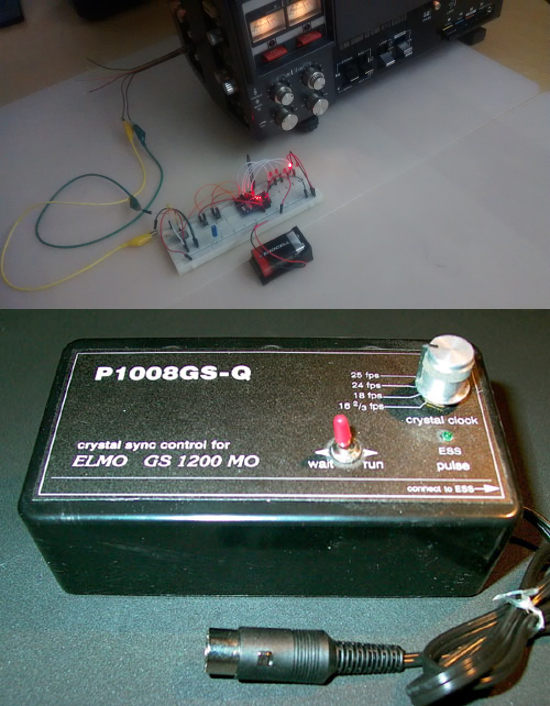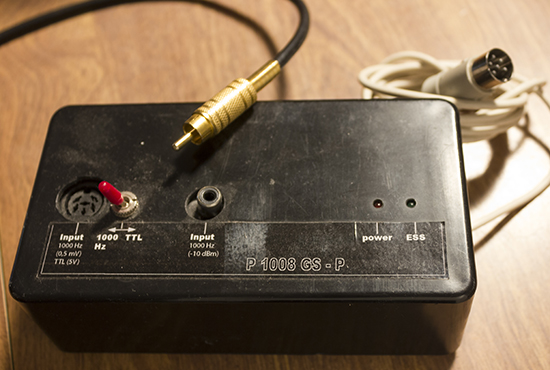|
Author
|
Topic: "Pedro Box"
|
|
|
|
|
|
|
|
|
|
|
Renzo Dal Bo
Film Handler
Posts: 70
From: Mogliano Veneto, Italy
Registered: Dec 2016
|
 posted November 18, 2017 04:22 PM
posted November 18, 2017 04:22 PM




Hi everyone,
I never had any type of Pedro's box, but reading a lot about that and its marvelous features and taking inspiration from a previous project of mine (where you can read about it here), I built a prototype of a sync box with all the characteristics of the old Pedro's box.
Despite it is a home made device, it works very well and it is able to generate sync pulses of fixed frequencies (16,667 - 18 - 23.976 - 24 - 25 fps) to drive the GS1200 with high accuracy through the ESS socket.
My box is based on an Arduino board and it is programmed to start and stop the sync pulses of a frequency, choosen from the above list, pressing a button.
It is also possible to provide the box of a secondary circuitry to generate the pulses at 25 fps, from a video (PAL) analog source.
Renzo
[ November 24, 2017, 11:52 AM: Message edited by: Renzo Dal Bo ]
| IP: Logged
|
|
|
|
Renzo Dal Bo
Film Handler
Posts: 70
From: Mogliano Veneto, Italy
Registered: Dec 2016
|
 posted November 20, 2017 05:15 AM
posted November 20, 2017 05:15 AM




Hi Maurizio, nice to meet you here.
Yes, of course, I could! But I don't think there is such an interest for a new sync box, as it can be easily substituted by a computer with a proper software.
My box, although full working, is still a raw project .
It would need a tester who own the original box to compare its good functioning. You could be that person!
If there is someone interested in this sync box, before to build other new boxes, I could send you the prototype for testing, if you agree.
Renzo
[ January 03, 2018, 04:32 PM: Message edited by: Renzo Dal Bo ]
| IP: Logged
|
|
|
|
|
|
Renzo Dal Bo
Film Handler
Posts: 70
From: Mogliano Veneto, Italy
Registered: Dec 2016
|
 posted November 24, 2017 11:45 AM
posted November 24, 2017 11:45 AM




Thank you, Paul and Maurizio, for your willingness to test my sync box for Elmo GS1200.
At the moment, my prototype is equivalent to the P1008GS-Q original sync box, but, in addition to the four original frequencies, it allows to sync the projector also to the NTSC frequency of 23,976 Hz.
As soon as I put the prototype in an appropriate "box", I will contact you to organize the comparison test.
Renzo

[ November 24, 2017, 05:13 PM: Message edited by: Renzo Dal Bo ]
| IP: Logged
|
|
|
|
Renzo Dal Bo
Film Handler
Posts: 70
From: Mogliano Veneto, Italy
Registered: Dec 2016
|
 posted January 04, 2018 06:03 PM
posted January 04, 2018 06:03 PM




Finally Boxed !!!
It took a bit of time to accommodate all the electronics in a box with small dimensions. For sure more time than to build the prototype. I wanted it was well fitted and rationally arranged.
Maurizio,
at the moment the sync box is powered by a 9V battery, but it is no problem to provide it with a socket for an external 9V DC power supply.
I am sorry for the craft label, I hope it makes to understand how the sync box works. After turning on the "Power" switch, the "Speed Selection" button allows you to select the desired speed, reported by a led. The "ESS Pulse" switch allows to start and stop the ESS pulse signals to send to the GS1200, connected by the DIN plug.
The accuracy of the pulses is very high. For all the speeds, the error is lower than one frame/hour.
Ready for third parties tests!
Renzo

[ January 07, 2018, 06:54 PM: Message edited by: Renzo Dal Bo ]
| IP: Logged
|
|
|
|
|
|
|
|
|
|
Renzo Dal Bo
Film Handler
Posts: 70
From: Mogliano Veneto, Italy
Registered: Dec 2016
|
 posted January 07, 2018 09:49 AM
posted January 07, 2018 09:49 AM




Thank you all for your positive and gratifying comments, but I am walking on eggshelds and here I wish to explain why.
I am only a passionate, just like you, that loves to experiment, above all to understand how the things work. I am not a professional, but only one who likes put his nose in different activitives. So my main target is to satisfy my curiosity and I never thought to gain money about that. When Maurizio asked me if I am willing to build the box for others, I answered positively, because it is always a pleasure to help other passionates when they are in need. To answer those who contacted me private to know if I sell this sync box, I say: "maybe, only if and when I will be sure it properly works".
I have to admit it is very hard to master all the variables of this task, maybe it is impossible. I try to explain myself despite my poor english.
In my project I can calibrate accurately the synch box in way it generates pulses taking, as reference, the crystal built in the Arduino board, so the projector is led by that. When you play separately the soundtrack, with your computer or a DVD player, and you want it to stay in sync with your projector, they take, as time reference, their own built in crystals. All the crystals produce relative time references and not absolute references. However precise, they could be a little different and drift for some reasons (one of these is the temperature). These very very small differences, sometime random, can produce in long times not acceptable differences. For example, an imperceptible lack of one thousandth of second at 24 fps, after an hour, produces an error of 86 frames.
To solve the problem, one simple and safe way is to adopt the same time reference source.
When you play concurrently by a computer the soundtrack and the track with the pulses, they will stay always in sync, because they refer to the same time reference produced by the computer itself.
So you already understand that to aspect a perfect sync for long times in a "wild" sync is almost impossible to achieve.
And, though I have never owned one, I believe also the Pedro's box is not able to keep the projector in sync for long time.
However, what I made to maintain a separate box, just like Pedro's one, and, in spite of everything, to improve its accuracy, is to "tune" my box to my computer or my DVD player. I don't want to bore you telling how, it would be complicated for me here.
Briefly, first I estimate the error and then I modify the program in the Arduino board to compensate it.
Therefore my box is very precise with my equipment, because it's tailored on it, and I always have the possibility to change its program and to adapt it to a new equipment. Usually they are tiny adjustments (some micro seconds).
So, at the moment, I cannot guarantee the same precision with other stuff. For now I would say my box is quite precise, I hope as precise as Pedro's box. This is the reason I asked someone, who have the Pedro's one, to test mine.
Maurizio, you are the man!
I already have your address, but I would like to contact you by phone, please could you send me your phone number private?
Thank you all again
Renzo
[ March 02, 2018, 04:26 AM: Message edited by: Renzo Dal Bo ]
| IP: Logged
|
|
|
|
|
|
|
|
|
|
|
|
|
|
Bill Brandenstein
Phenomenal Film Handler
Posts: 1632
From: California
Registered: Aug 2007
|
 posted January 18, 2018 12:08 PM
posted January 18, 2018 12:08 PM



So here's what I have. This has to be the simplest of Pedro boxes:

It has an input on the left side for 9V DC power and I had to supply my own "wall wart." Otherwise, it's very simple: you have audio waveform inputs either into the Bauer DIN jack, or the RCA jack. As you see, Pedro labelled it for -10dB audio with 1000Hz cue beeps, so this box has no timing ability of its own. All it does is convert an audio trigger into the square pulse read by the GS-1200.
He sent a CD with my box with 1Khz pulse tracks at various frame rates, although I know now that some of the timing wasn't perfectly correct. Any consumer line-level audio device can thus play into this device, and if the level isn't hot enough, the green LED doesn't illuminate. Under normal operation, the LED pulses once for each trigger pulse it "hears."
So I ended up making my own control tracks with 1KHz "beeps" about 10ms long, then an appropriate length of silence. At 48KHz (which is what all DVDs use) a framerate of 23.976 corresponds neatly to a beep for every 2002 audio samples. Lots of other options work also, and I have quite a few different files for different frame rates. They can be shared!!!
So you can make a control CD of a mono track with the pulse on one channel and the audio content on the other. I've "added" sound to silent prints this way. But most often I use a computer. Almost any Windows office computer now has audio on the motherboard with multiple outputs, and as long as you can set the driver to use them independently, you're good to go. Any audio software that handles more than one track and file at a time can be used. So you send a pulse file to one output hooked up to this Pedro box, and the other output to whatever you hear your sound through. It takes two pulses to bring the projector up to speed, so all of my ESS sessions have two pulses before the "Start" frame cue. As mentioned before, a Dolby Digital SPDIF-wave file will play perfectly over a digital connection in this manner while a pulse track plays out of an analog headphone jack, but it requires Windows XP and Adobe Audition 3.0 to keep the SPDIF data intact and undithered. Of all the Adobe / Cool Edit products, that's the only version that can pass an unaltered bitstream. I've not tried this with any other software.
It's also important to note that whatever speed the trigger cue file is made for is matched by the projector settings. The Elmo GS-1200 has speed and level controls for the pulse, and a little meter for the latter. If you have a pulse playing at 24 fps and the projector is set to 18, or rates match but the speed control is bumped much either way, the meter will dance around most unhappily. You can run and lock any speed within the projector's range so long as you match the projector's controls to your ESS "playback" so the Elmo "knows" what to expect. The meter sits still and stable when it's done right.
| IP: Logged
|
|
|



 UBBFriend: Email this page to someone!
UBBFriend: Email this page to someone!
 Printer-friendly view of this topic
Printer-friendly view of this topic









![[Smile]](smile.gif)




